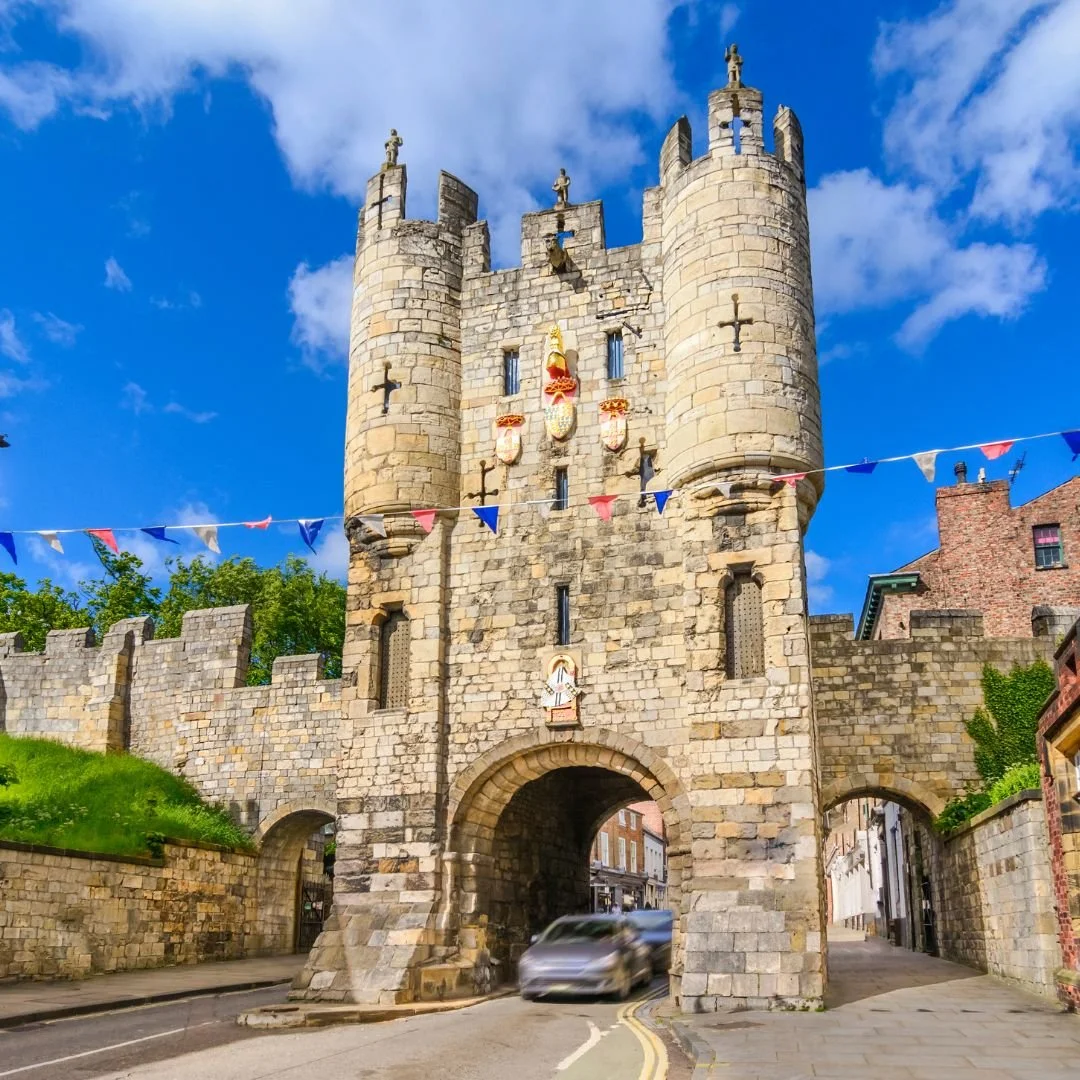Micklegate Bar: Ancient Gateway In York
Micklegate Bar was the most important of York’s four main medieval gateways and the focus for grand events.
The Henry VII Experience (a museum) is located inside the medieval gateway, and it’s encased in history!
For those of you interesting in visiting, the museum explores Henry VII's links to York, the story of Micklegate and its role in the history of York.
York city walls have stood since Roman times, with the original ramparts and timber palisades replaced by stone walls.
York features the longest town walls in England, and it also has more miles of intact wall than any other city in England too.
Constructed primarily in the 12th century, Micklegate Bar (pictured above) was initially a wooden gate before being rebuilt in stone in the 12th and 14th centuries.
Its imposing facade, complete with battlements and arrow slits, served both as a defensive fortress and a symbolic entry point into the heart of York.
At least half a dozen reigning monarchs have passed through this gate and by tradition they stop here to ask the Lord Mayor's permission to enter the city.
Notably, in the tradition of the city, English kings made their ceremonial entrance through Micklegate Bar on their way to their coronations at the York Minster.
Like the other main gates, Micklegate Bar originally had a barbican built on the front, in this case demolished in 1826.
The gate also served as a foreboding display for traitors and dissenters…
Heads of rebels and enemies were displayed on spikes above the gate, serving as a stark warning to potential adversaries.
This macabre practice continued for centuries and added a chilling aspect to the gate's history.
The last of the severed heads was removed in 1754.
Replica heads are displayed in the museum (inside the gateway) if you have a mind to relive that particular feature of Micklegate's past!
Micklegate Bar has four storeys - the main, outer arch and passage walls contain reused Roman masonry and gritstone.
However, it is on the other side of the river from the original Roman walls so, it was not a gate way back then.
The small statues on top (pictured in the photos above) were carved by R. Ridley in 1950 as replacements for earlier ones.
It did have Barbican that jutted out westward, to keep pesky invaders at bay.
This was removed relatively recently in 1826. However, the doors of it that lead to the walkways around the walls still exist. The wooden inner face the gate was rebuilt in stone by P. Atknison junior in 1827.
In the passage walls that are beneath the outer arch, bricked up doorways and portcullis grooves can still be seen.
Due to traffic through the gate, the safest way to view these is in a car waiting for the lights to change!
The arch directly to the left of the main arch, as you look at the front, is a recent addition to accommodate increased road traffic.
Also, the smaller arches at the far left and right sides, are recent, to accommodate pedestrians.
Within the historic gatehouse is the Henry VII Experience, exploring the first Tudor monarch's life and his connection to York.
One feature is a suitably gruesome replica of the head of Richard, the 3rd Duke of York.
Tradition says that after Richard was slain at the Battle of Wakefield in 1460 his head was chopped off and displayed atop Micklegate, adorned with a paper crown to mock his claim to the throne.
The museum has a variety of fascinating artefacts illustrating local history, including a display of a medieval apothecary's remedies.
Not only was Micklegate a gateway into medieval York, but it served as a dwelling house (interior pictured below).
A special exhibition in the museum shows what it was like for the families that lived within these thick stone walls.
Another exhibition area tells the bloody tale of the battle of Towton, the decisive battle of the Wars of the Roses.
The attraction has positive reviews on TripAdvisor, a recent visitor said: “We walked through here several times during our stay in York, and it always gave us a satisfying sense of ‘entering’ the city proper.
”Visually impressive, historically important, and beautifully restored, it is, in my opinion, the most beautiful of the city Bars.”
Note that Micklegate Bar is a historic building and features uneven floors, narrow staircases and small spaces.
Just around the corner from Micklegate Bar is Clifford’s Tower, the largest remaining building of York Castle, northern England’s greatest medieval royal fortress.
With new updates for 2023, including a dramatic roof deck, internal walkways and soundscape interpretation - the fascinating story of Clifford's Tower will finally be told.
The tower offers unrivalled views over the ancient city whilst the new interpretation makes the tower’s history and interior more accessible than they’ve been for centuries, bringing its dramatic and sometimes tragic story to life as never before.
Standing as a proud symbol of the power of England's medieval kings; the tower was originally built by William the Conqueror to subdue the rebels of the north, it was twice burned to the ground, before being rebuilt by Henry III in the 13th century.
The tower (pictured below) takes its name from one grisly incident in its long history, when Roger de Clifford was executed for treason against Edward II and hanged in chains from the tower walls.
With sweeping panoramic views of York and the surrounding countryside, it isn't hard to see why Clifford's Tower played such a crucial role in the control of northern England.
York's city centre as a whole is surrounded by historic walls, which are free to access on foot throughout the year.
No visit to York would be complete without a walk around the City Walls - at 3.4 kilometres long, the beautifully preserved walls are the longest medieval town walls in the country.
A walk all round the walls (going up on the wall-walk, or just using the pavement outside them) takes about 2 hours.
It will take longer if you pause much to look at things like the four main ‘bars’ (these are fortified gateways).
The Friends of York Walls provide an online guide to York's City Walls Trail which covers the location of the walls, access points and many maps and pictures.
Today, York's City Walls are managed and maintained by the City of York Council.
Another nearby landmark work visiting here is, of course, York Minster - one of the world’s most magnificent cathedrals.
Since the 7th century, the Minster has been at the centre of Christianity in the north of England and today remains a thriving church rooted in the daily offering of worship and prayer.
The Minster was built for the glory of God.
Every aspect of this ancient building - from the exquisite, handcrafted stone through to the unrivalled collection of medieval stained glass - tells the story of Jesus Christ.
The magnificent cathedral has attracted people from across the globe for more than 1000 years.
Sightseeing visits can be booked in advance online - check their official website for all the details, it’s definitely worth a visit!
If you enjoyed this blog post, please follow Exploring GB on Facebook for daily travel content and inspiration.
Don’t forget to check out our latest blog posts below!
Thank you for visiting Exploring GB.
Hello, World!





















